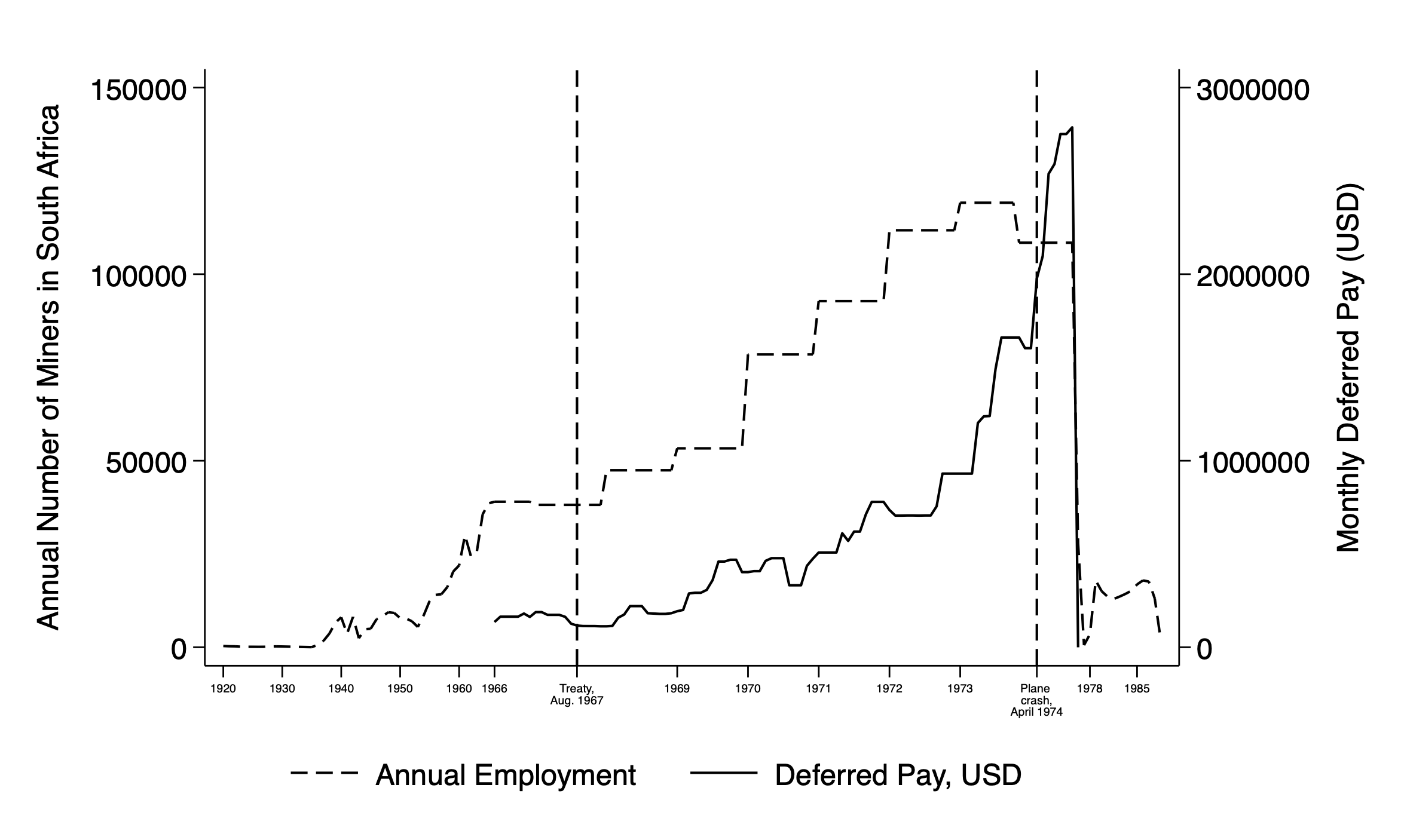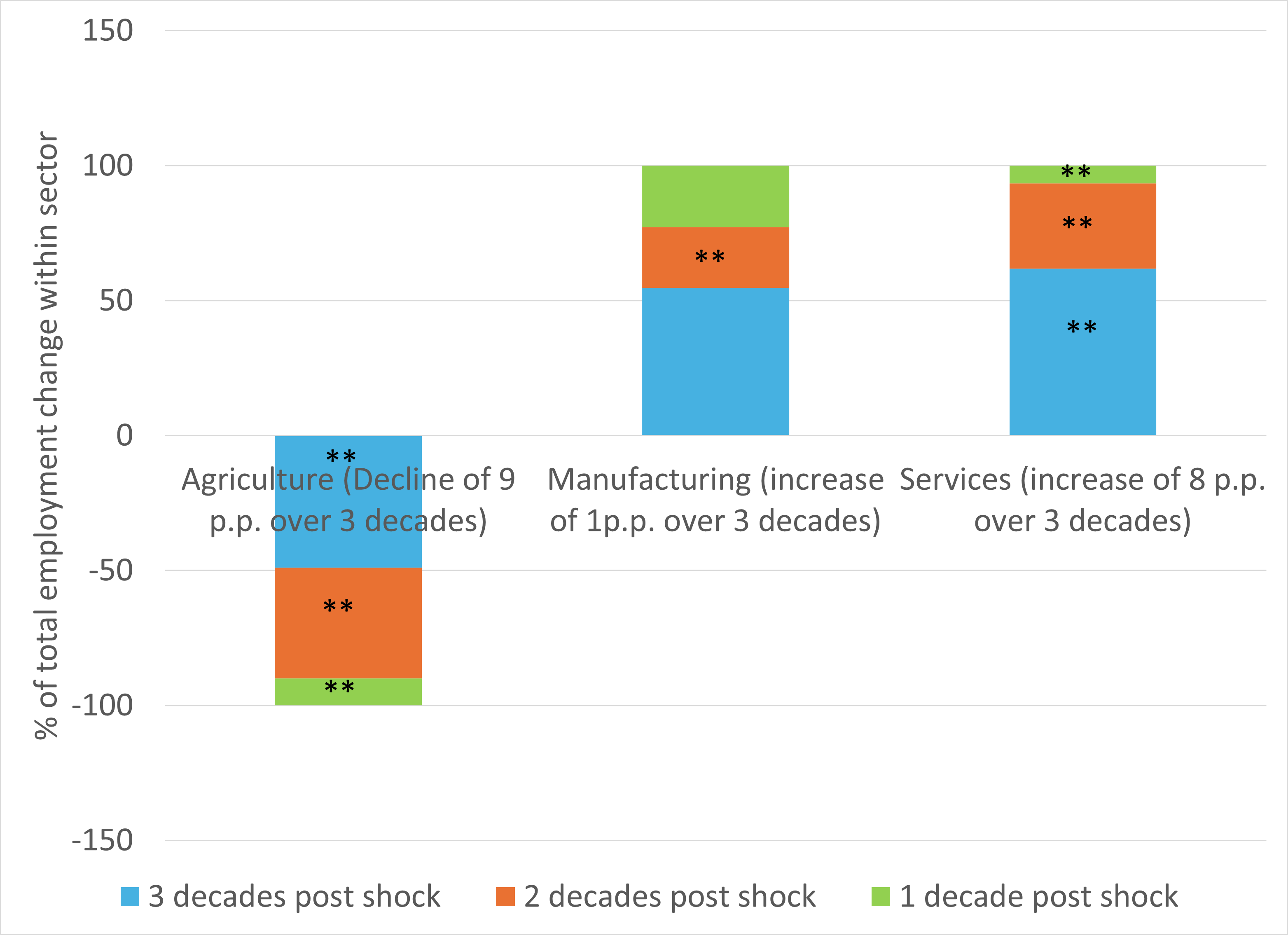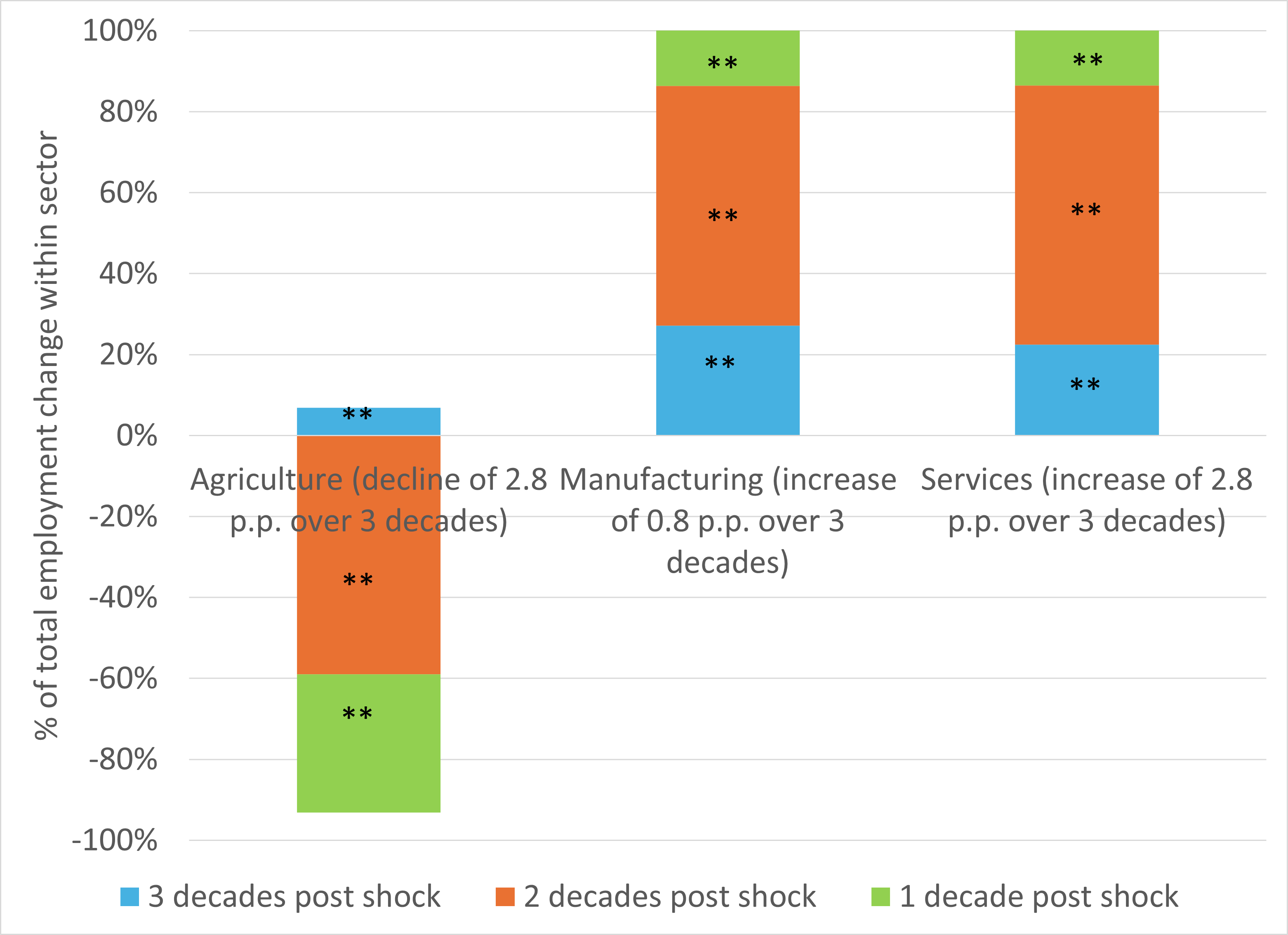
Evidence from Malawi shows that temporary capital inflows from migrants can permanently reshape rural labour markets by jumpstarting a structural transformation out of agriculture.
Structural transformation – broadly defined as the reallocation of labour and capital away from agriculture towards better jobs in manufacturing and services – is elusive in many low-income countries. Identifying the triggers for structural transformation as well as the frictions slowing down this reallocation process is of paramount importance because, as Kuznets (1979) noted, it is “impossible to attain high rates of growth of per capita…without commensurate substantial shifts in the shares of various sectors.”
At the micro level, Balboni et al (2022) have shown that large transfers (in their paper, cows were randomised to households in Bangladesh) can effectively create better jobs for the poor, leading to a shift in labour away from low-productivity agriculture. At an aggregate level, technology and trade shocks can stimulate structural transformation in labour markets, as evidenced by research on Brazil (Bustos et al. 2016) and Vietnam (McCaig and Pavcnik 2018), Asghar and McCaig 2024). Staying at this more macro level, we explore the role that capital amassed by international migrants could play in triggering structural transformation.
In Dinkelman, Kumchulesi, and Mariotti (forthcoming), we use archival material on remittances combined with historical census data to study a natural experiment that generated large and unexpected shocks to international migration and migrant capital flows in the 1970s in Malawi. Our evidence shows that even temporary capital inflows from migrants can permanently reshape rural labour markets over decades, by jumpstarting a structural transformation out of agriculture.
Malawi at independence: A nation of farmers
At independence in 1964, Malawi was a subsistence economy. Agriculture accounted for 55% of Malawian GDP (Thomas 1975), of which 62% was produced by subsistence farmers (IBRD 1973). Almost all four million Malawians lived and worked in rural areas (Thomas 1975). Signs of economic dynamism were few: by 1977, 94% of women and 76 % of men were still employed in the agricultural sector, and the agricultural estate sector was still the largest formal employer.
Only limited employment was available in the non-agricultural sector. As Thomas (1975) notes, there was “one cigarette factory, one oil expression plant, two clothing factories, two blanket factories, one cement mill, two sweet factories, one soap factory, and one vehicle assembly plant which produced…20 vehicles in 1964.”
A gateway to capital accumulation: Migrant work on South African gold mines
Labour migration to other countries in southern Africa had long offered Malawian men a chance to earn more than working at home. In the 1960s, new and highly lucrative migration opportunities emerged. While South Africa had not been a large recipient of Malawian labour in the colonial period, this changed in 1967 with a new bilateral treaty that increased circular labour migration from Malawi to the South African gold mines by 200%. The labour treaty allowed workers to embark on two-year contracts in South Africa, requiring them to return home after that time in order to claim the mandated minimum 60% of their earnings as deferred pay. Between 1967 and 1974 while the treaty was in place, migration to South Africa channelled 53 million USD back to rural sending communities in Malawi. The treaty was unexpectedly cancelled in 1974 following a deadly miner plane crash. Migrant capital flows plummeted, and labour migration never recovered. Figure 1 depicts this dramatic surge and then permanent decline of Malawian migrant workers and capital flows over time.
Figure 1: Surge and decline of migrant workers and capital flows over time

Source: Dinkelman, Kumchulesi, and Mariotti (forthcoming)
We study how this unexpected end of the treaty period affected local labour markets, notably sectoral employment. We address common identification challenges in a study of the effects of migration by exploiting the quasi-random nature of recruitment to South Africa as well as the unexpected end to the treaty.
Bringing historical data on remittances to contemporary census data on employment
Combining remittance data from the National Archives in Malawi, The Employment Bureau of Africa (TEBA) archives in South Africa, and Rhodes House Library at Oxford University in the UK with four decades of Malawian census data, we construct a panel data set of districts that allows us to investigate the effects of the migrant capital inflows on the share of women and men working in agriculture, manufacturing, and services over time.
We focus on the spatial variation in migrant capital returning to different districts in Malawi in the period immediately after the plane crash (marked by the second vertical line in Figure 1). This allows us to use the movement of men and money that is least related to local district conditions in Malawi. In the short period between April 1974 and December 1975, almost 120 000 men returned with their remittances amounting to 10 million USD, or about 73 USD (87.6 Kwacha) per returning migrant.
Migrant capital triggered a shift away from agriculture and more so for women
How did this exceptional capital inflow and return of migrant workers affect workers’ choices about sector of employment in the following decades? Comparing high migrant capital-receiving districts to low migrant capital-receiving districts in Figure 2a, in the three decades following the end of the treaty, we find that the initial shift of women out of agriculture and towards services was slow, picking up pace in later decades, with the largest shift out of farming and into services occurring three decades after the shock. Figure 2b shows similar patterns of sectoral reallocation of labour across high and low migrant-capital receiving districts for men. In terms of the opportunity for structural change, these results are important in that they show people shifting towards services in response to large capital inflows, rather than investing in and staying in agriculture.
Figure 2a: Impacts of migrant capital inflows on sectoral employment of women

Figure 2b: Impacts of migrant capital inflows on sectoral employment of men

Source: See Dinkelman, Kumchulesi, and Mariotti (forthcoming) for the regression results underlying these figures. Each column shows our estimates for the overall effect of migrant capital inflows post-plane crash on the change in share of female or male employment in each sector. Within each bar, we show how much of this total change happens in each decade after the end of migration. ** indicates significance at the 5% level.
Did long-run wealth increase in areas receiving more migrant money?
Circling back to Kuznets: how did these migrant capital-induced employment shifts out of agriculture affect economic growth or living standards in Malawi? Using Demographic and Health Survey Data for Malawi from 1992 we find that in districts receiving more migrant money, housing quality, access to electricity, ownership of radios, cars, motorcycles, bicycles, access to toilets and water sources is significantly higher, 15 years after the migrant repatriation.
We argue, and show in a companion paper (Dinkelman and Mariotti 2016, summarised in Dinkelman 2020) that part of this wealth effect is driven by an increase in the acquisition of human capital by the next generation that was also facilitated by the return of migrant money. This link between labour migration, return remittances, and investment in the next generation of workers is a familiar dynamic in other labour-exporting countries, as Khanna et al. (2022) show for the Philippines. However, not all of the wealth effects that we find are driven by the younger generation. We also see an increase in wealth-related assets for older household heads. This suggests a dual impact of remittances: on immediate wealth and perpetuating into the future.
Concluding remarks
Without structural change in an economy, there is little hope for developing countries to alleviate poverty and its attendant maladies. Historically, structural change has emerged from technology shocks, or income growth stimulated through international trade (for example). In the absence of these options in smaller countries of sub-Saharan Africa, the opportunity for individuals to earn an income, especially outside of their own country, can hasten structural change and lead to long lasting wealth improvements. Labour migration could be a promising avenue for development policy.
References
Asghar, R and B McCaig (2024), "Trade, Structural Change and Labour Market Transitions in Vietnam", Working Paper 93, https://steg.cepr.org/sites/default/files/2024-03/WP093_AsgharMcCaig_TradeStructuralTransformationandLabourMarketConditionsinVietnam.pdf
Balboni, C, O Bandiera, R Burgess, M Ghatak, and A Heil (2022), "Why Do People Stay Poor?", The Quarterly Journal of Economics, 137(2): 785–844, https://doi.org/10.1093/qje/qjab045.
Bossavie, L, J-S Görlach, C Özden, and H Wang, "From Migrant Worker to Owner: When Temporary Migration Is Used to Start One’s Own Business", VoxDev, Accessed May 1, 2024, https://voxdev.org/topic/migration-urbanisation/migrant-worker-owner-when-temporary-migration-used-start-ones-own.
Bucheli, J and M Fontenla, "Coming Home to Prosperity: How Return Migration Promotes Economic Development", VoxDev, Accessed May 1, 2024, https://voxdev.org/topic/migration-urbanisation/coming-home-prosperity-how-return-migration-promotes-economic.
Bustos, P, B Caprettini, and J Ponticelli (2016), "Agricultural Productivity and Structural Transformation: Evidence from Brazil", American Economic Review, 106(6): 1320–65, https://doi.org/10.1257/aer.20131061.
Dinkelman, T, "How Remittances Affect Long-Run Economic Change in Rural Labour Markets", VoxDev, Accessed May 1, 2024, https://voxdev.org/topic/migration-urbanisation/how-remittances-affect-long-run-economic-change-rural-labour-markets.
Dinkelman, T, G Kumchulesi, and M Mariotti, "Labor migration, capital accumulation, and the structure of rural labor markets", Review of Economics and Statistics, forthcoming, NBER Working Paper No. 32144, https://doi.org/10.3386/w32144.
Dinkelman, T and M Mariotti (2016), "The Long-Run Effects of Labor Migration on Human Capital Formation in Communities of Origin", American Economic Journal: Applied Economics, 8(4): 1–35, https://doi.org/10.1257/app.20150405.
Khanna, G, E Murathanoglu, C B Theoharides, and D Yang (2022), "Abundance from Abroad: Migrant Income and Long-Run Economic Development", Working Paper, National Bureau of Economic Research, https://doi.org/10.3386/w29862.
Kuznets, S (1979), "Growth and Structural Shifts", in W Galenson (Ed.), Economic Growth and Structural Change in Taiwan, London: Cornell University Press.
McCaig, B and N Pavcnik (2018), "Export Markets and Labor Allocation in a Low-Income Country", American Economic Review, 108(7): 1899–1941, https://doi.org/10.1257/aer.20141096.
Thomas, S (1975), "Economic Developments in Malawi since Independence", Journal of Southern African Studies, 2(1): 30–51, https://doi.org/10.1080/03057077508707941.


